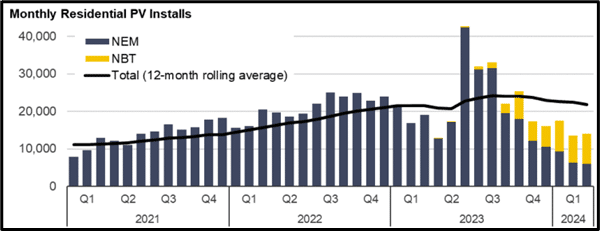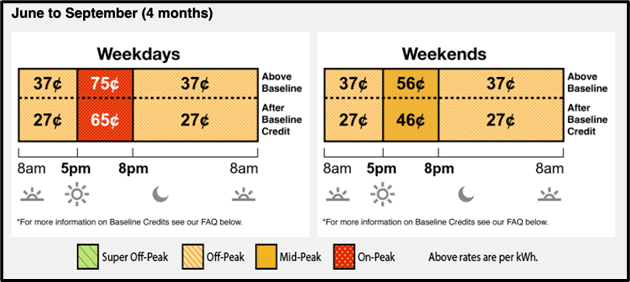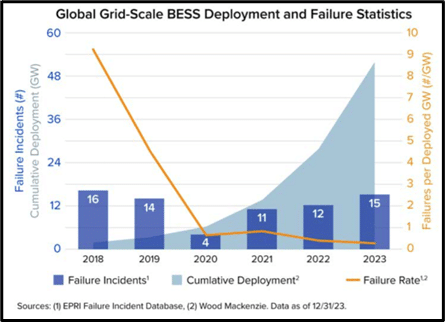The lithium battery MESS: Will restrictive fire codes drive consumers to unpermitted home battery systems?

I am increasingly concerned that the solar and storage industry is facing the biggest safety challenge of its 50-year history. The convergence of several recent developments fuel my concerns:
- Utility rate changes and the death of net metering.
- Reduced grid reliability.
- Growing concerns over lithium battery safety.
- Increased complexities in ESS codes, standards, and permitting.
- The rapid growth of inexpensive, unlisted, and unpermitted lithium battery systems.
Those bullet points make for a volatile chemistry. In this article, I will provide background for each of those factors, and explain the consequences (intended and unintended) for home energy storage systems (ESS), customer and installers. Lastly, I will try to offer suggestions for a way out of this looming lithium battery MESS.
Utility rate changes are driving the financial need for home ESS
When I started working in solar in the mid-2000s, the industry was a small fraction of its current size. At the time, batteries were still common in home solar systems, overwhelmingly for off-grid homes in remote areas. Net energy metering (NEM) supercharged the grid-tie sector, and by 2010, grid-tie systems without batteries grew to dominate the solar industry. At that time, very few grid-tie solar owners wanted to install lead-acid battery systems that were expensive, often unreliable, and required regular maintenance.
This started to change around 2015 when lithium battery costs declined and grid power rates started to skyrocket. In 2023, California’s big three utilities killed the NEM 2 program. PG&E, Southern California Edison, and San Diego Gas & Electric slashed the amount credited for backfed kilowatt-hours with their new “Net Billing Tariff” (NBT). NBT is often called NEM 3, but it bears little resemblance to net energy metering. Instead of getting full retail rates for excess electricity exported to the grid, homeowners earn a measly 6 to 8 cents per kWh for back-fed power. The dramatic reduction in utility compensation for excess power in 2023 resulted in an equally dramatic decline in rooftop solar installations in California.

Thankfully, there is a silver lining to NBT. Evening electricity rates skyrocketed to 40-75+ cents/kWh in the hotter months. This means most California homeowners that add a 20 kWh battery to their new solar system can get a 7-9 year payback, since they can charge the battery during the day and use the stored energy in the evening. As a result of the attractive economics, the majority of new solar projects in California now include batteries. Factor in the increasingly unreliable and aging utility grid, and you can see why industry analysts are projecting major growth in home ESS.

Not so fast: Lithium battery safety concerns are growing
Data from the Electric Power Research Institute (EPRI) show lithium ESS fires declined noticeably between 2018 and 2023, and National Transportation Safety Board (NTSB) statistics show EVs are 11 times less likely to catch on fire compared to vehicles with gas / diesel engines.

However, deaths caused by lithium battery fires are increasing in large cities. In New York City, there were over 220 lithium battery fires in 2022, with at least 10 deaths and 226 injuries in 2021 and 2022 combined.
To be clear: None of these fires were caused by home ESS. The vast majority of these lithium battery fires have been caused by e-bike and micro-mobility batteries, and the vast majority of these batteries were unlisted, and sometimes modified, damaged, or abused.
Concerned about these lithium battery fires, the fire safety community developed new code requirements for home ESS starting with the 2018 International Fire Code (IFC) and 2018 International Residential Code (IRC). These introduced the mandate for using UL 9540 listed energy storage systems. In 2021, the IFC and IRC added additional restrictions for system size, siting, spacing, fire detection, and vehicle impact protection.
Thankfully, UL 9540 has worked as hoped, and UL 9540 listed lithium battery fires and explosions have been rare.
Regardless of the strong safety track record, a growing number of cities in highly populated areas have imposed additional restrictions, making legal installation of batteries impractical or impossible. In some jurisdictions, batteries are only allowed outdoors. Some authorities having jurisdiction (AHJs) imposed more restrictive requirements for locations and setbacks from windows, doors, and property lines. These extra restrictions often make finding a suitable location challenging.
As a result of the increasing difficulties of legal installation, some contractors and consumers are disregarding the safety codes.
Enter the black market: Unlisted batteries meet demand for home ESS
These jurisdictional restrictions have prompted an increasing number of ESS customers to buy inexpensive, unlisted lithium batteries for home power. Many customers figure, “Why pay a contractor a few thousand dollars for a wall-mounted battery when you can save thousands and buy one from eBay, Alibaba, Amazon, or many other online retailers?”
Several retailers of portable lithium batteries are claiming you can install their batteries to power your home in an outage without needing a permit or interconnection application. This is NOT TRUE.
There are no restrictions to using a portable battery if you power loads with an extension cord. When you power the premises wiring in a home, you must use a UL 9540 listed ESS to comply with fire and residential code in more than 90% of the United States.
Moreover, these unlisted portable battery systems are designed for low cost — not safety. Consider the common use case: Inexpensive portable batteries roll around on wheels, get tossed into the bed of a pickup truck, are bounced down the road to the campsite through the mud and snow, and get hosed off back home before being stowed for the next power outage. This does not sound like a good formula for lithium battery safety.
Budget-driven customers who make the mistake of buying these products fail to understand they are intended for occasional use — not daily cycling — and they are not validated for electrical or fire safety.
Given these growing safety concerns, federal and state governments and safety officials are exploring new regulations to control and limit use of these portable systems across the country.
Those who disregard safety and opt for the low-cost solution will likely be disappointed with long-term performance, and may create an avoidable safety risk for their home and family.
MESSinformation
I certainly sympathize with homeowners that are being squeezed by high electricity rates, reduced compensation for solar kWhs, and unfairly restrictive codes and permitting issues. However, I am much more concerned that the growing market demand for inexpensive, unlisted, poor quality ESS products is setting the stage for a less safe landscape for home energy storage.
The repercussions for skimping on safety and failing to comply with clearly stated code requirements can be devastating for homeowners and contractors alike. Many homeowners wishing to get battery backup fail to appreciate that these cheap, unlisted ESS are not validated for safety. Furthermore, since many are not code compliant for the application, that means they are not legal for use in those home applications. Any losses from fires or explosions of these devices may not be covered by insurance companies.
Even if a fire or explosion does not occur, the longevity of these low-cost systems is a major question. I am confident many of these low-cost batteries will become useless bricks in a few short years.
These problems are not just restricted to DIY projects. Some uninformed contractors are making the mistake of purchasing and reselling these unlisted ESS products. They are attracted by the promise of saving money only to learn later they installed an illegal ESS.
Complicating the situation further, many AHJs do not know the code requirements and standards well enough to enforce the regulations properly. This is true especially in less populated areas, or areas newer to solar and ESS installations. As a result, many systems are being installed that do not comply with the code (aka the law).
Be forewarned: You cannot always rely on the AHJ to catch code violations. Many do not know the requirements yet, and any problems resulting from a non-code-compliant installation are still the legal responsibility of the installing contractor, even if the local building department permits, inspects, and approves the installation. The contractor is on the hook if a battery explodes, burns down the house, kills occupants, and/or sets the neighborhood on fire.
Contractors, beware the following deceptions in product marketing.
The UL 9540A deception. It makes me angry to see a growing number of ESS manufacturers and online retailers with questionable ethics try to fool contractors and DIY’ers by claiming their systems are code compliant when they are not. Again: To comply with the fire code, the ESS must be “UL 9540” certified in ~90% of the United States.
I see a growing number of manufacturers claiming their ESS is properly “certified” without showing any evidence of UL 9540 certification. There is a major difference between UL 9540 and UL 9540A. The latter is not a certification, it is only a thermal runaway test. The 9540A test is only one of many tests required to achieve UL 9540 certification. If you see products that claim UL 9540A “certification” without showing evidence of UL 9540 certification, I would recommend you not buy their system. They are being purposely deceptive by trying to give the impression their ESS is compliant with the code, when in fact it is not.
The UL 1973 deception. If a manufacturer claims their ESS is UL 1973 certified, but they are not listed to UL 9540, the system is not compliant with the code. UL 1973 is not sufficient for the ESS used to power wiring systems in a home or business. The system must be UL 9540 listed.
How do we fix this?
First, we should recognize that NEM is disappearing quickly in the most active solar markets. At the same time, EVs and home electrification are driving a dramatic increase in electrical demand. The need for more electricity is outpacing the abilities of the centralized generation model of the traditional grid. Rooftop solar + storage systems offer one of the most cost-effective approaches to stabilizing and supporting our future electrical grids, and wise utilities will embrace the benefits of rooftop solar and storage. Failure to do so will mean a less stable grid and all the negative economic impacts that would create.
To support this future expansion of distributed generation, it is imperative to address the regulatory MESS. The solar + storage industry has three options:
- Do nothing, and see rooftop solar and storage stagnate.
- Disregard the code requirements (i.e., break the law).
- Invest in the codes / standards development process.
Option 1 is undesirable, option 2 is illegal, so option 3 is the only practical course of action if we hope to deploy more solar nationwide.
Therefore, it is critically important for the industry to invest in the codes and standards development process. If the solar + storage industry were to invest a few million dollars in codes and standards development today, the future savings could be 50-100 times greater than the amount invested. Delays in addressing these codes and standards problems shifts a tremendous cost burden to future homeowners and restricts industry growth.
Get involved! During my years working in codes and standards, I have noticed the rules are made by those who show up and speak up. Sadly, those who show up and speak up are often not the best qualified to make the rules.
While we have seen increased engagement from the industry, we are still underrepresented in the codes and standard making processes. As a result the rules are made predominantly by safety officials, and as you would expect, they tend to err on the side of caution (more restrictions).
Fixing this problem requires more manufacturers and installers to dedicate knowledgeable engineers and technicians to show up and speak up at industry meetings to help craft more effective rules.
As the old saying goes, “If you are not at the table, you are on the menu.” Current regulations are complicated and expensive, and further development of standards and codes is necessary to improve the ability for homeowners and contractors to install safe and legal ESS.
If you share my concerns, you can get involved with the organizations shown below, which are most active in the development, dissemination, and education of solar and storage codes and standards for ESS. I encourage you to show up and speak up. The industry needs you!
Jeff Spies is president of Planet Plan Sets, a full-service provider of solar and storage plan drafting and interconnection application processing. He also serves as Secretary for both NABCEP and the California Solar and Storage Association where he chairs the Codes and Standards Committee. Jeff also serves on the UL 9540 Technical Committee for ESS and is a founding member of the Sustainable Energy Action Committee (SEAC) where he serves on the steering committee.
Get involved
To learn more on this issue and to get involved, you can join the following organizations that are most engaged in the development and understanding of the codes and standards for home ESS.
SEAC | The Sustainable Energy Action Committee is a volunteer organization founded by a diverse group of Subject Matter Experts (SME) from a broad cross section of key stakeholder groups including building officials, test labs, manufacturers, installers, and code experts. These SMEs work together to develop guidelines for the use of codes and standards in the permitting and inspection of renewable energy systems nationwide. SEAC conducts monthly general meetings open to all and has several working groups focused on energy storage systems that meet regularly.
CALSSA | The California Solar and Storage Association is actively engaged in the development, dissemination, and education of codes and standards for industry and building departments. CALSSA holds regular meetings of the Codes, Standards and Permitting Committee meeting.
ICC | The International Code Council develops the International Fire Code (IFC) and the International Residential Code (IRC), which are used in most of the U.S. The ICC code development process is described at their website.
NFPA | The National Fire Protection Association develops the NFPA 1 fire code used in a few states and the NFPA 855 ESS safety standard. NFPA 855 is becoming more applicable as the months go by and may be integrated into future versions of the IFC and IRC. You can learn more about the NFPA codes and standards development process at the link above.
UL Standards | The UL 9540 technical committee meetings are open to members of the industry and members of the public. Those who wish to join the technical committee must go through an application process at the link above.





Comments are closed here.